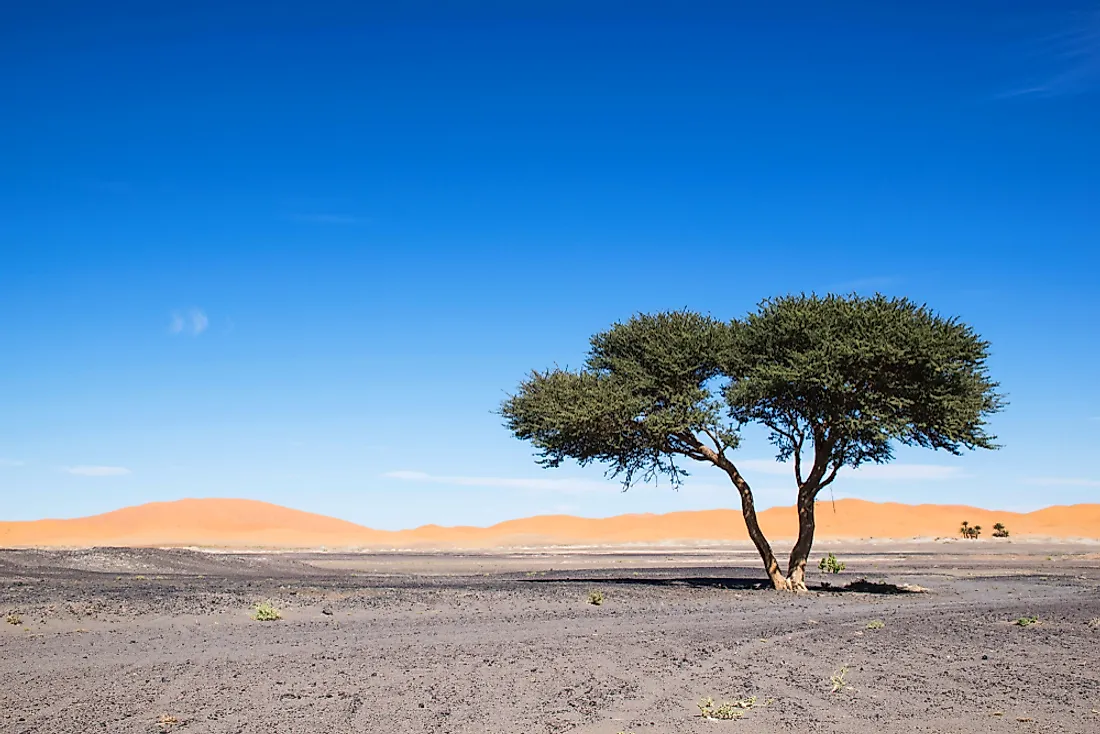Plants That Grow In The Sahara Desert

The name of Sahara Desert paints a picture of a limitless, barren sandy landscape for most of us. Although the fact is true to some extent as there are extensive patches of the Sahara that are completely devoid of life, other parts of the desert do have a significant diversity of flora and fauna that are well-adapted to survive in the extreme conditions that the desert has to offer. Some of the plants growing in the Sahara Desert have been mentioned below.
Laperrine's Olive Tree
An olive tree in the Sahara desert is hard to imagine. However, Laperrine's olive tree, the Saharan cousin of Mediterranean olive trees, does grow in the Sahara. This tree is extremely drought resistant and holds the potential to be used as a genetic resource to improve its domestic counterparts. The tree grows in the Saharan highlands where it is used as a source of wood for the local populations. The leaves of the tree are utilized in preparing traditional medicines and as fodder for livestock. Today, there is a great need to save Laperrine's olive tree. Its vegetative reproduction method and limited gene flow combined with climate change have decreased its population drastically. Conservation of this tree is thus of paramount importance.
Saharan Cypress
Another tree that grows in the mountains of Sahara, the Saharan Cypress is a very rare species of coniferous tree. It is native to the Sahara’s Tassili n'Ajjer mountains. The population of this tree stands isolated from any other tree. Classified as critically endangered, only about 233 specimens of the Saharan cypress remain standing today. Many of these are about 2000 years old. The largest one has a circumference of 12 m and is named Tin-Balalan. Increased desertification of the Sahara has suppressed regeneration to a great extent. Only around 30 mm rainfall is received each year in the area where these trees grow. The Saharan cypress is different from its Mediterranean counterpart in a number of features like a unique reproductive system of male apomixis, bluer foliage, present of a white resin spot on every leaf, etc. In some parts of Europe, the Saharan cypress is cultivated as part of an effort to conserve but also as an ornamental tree.
Date Palm
Dates are almost synonymous with desert and the Sahara Desert is no exception. The date is a flowering plant species that belongs to the Arecaceae or palm family. The edible sweet fruit produced by the date palm one of the staples of the diet of desert-dwellers. Date trees grow up to 21 to 23 m tall and grow singly or form a clump where several stems share a single root system. Dates are wind-pollinated in nature. However, oasis horticultural practices in the Sahara involve manual pollination of dates.
Desert Thyme
Desert thyme also grows in the Sahara highlands and other parts of the desert. This plant requires very little water for development, flowering, and maintenance. Hot, sunny locations with well-drained soil are ideal for its cultivation. Thyme has a shrubby, dried-out appearance but is extremely tolerant of harsh conditions. Thyme is used for medicinal, culinary, and ornamental purposes.
Tamarisk
In the western coastal zone of the Sahara, halophytic plants like the Tamarix senegalensis are found. Tamarisk is a small twiggy shrub that grows in saline desert soil and seashores. It has dry, scale-like leaves and flowers. The plant’s roots help reduce soil erosion along the dry coastal region where it grows.
Acacia
Also known as wattles, acacia is a genus of trees and shrubs belonging to the Mimosoideae subfamily of the Fabaceae family. Acacia is another plant that is integral to the desert ecosystem. In fact, acacia refers to a heterogeneous group of plants ranging from large trees to mat-like subshrubs. The plants are extremely useful to the desert dwellers and are used for food, fodder, firewood, tannin, etc.
Doum Palm
The doum palm is another one of the few trees that grow in the Sahara. It is a palm tree that produced edible fruit. In the Sahara, the doum palm grows in places with sufficient groundwater. It is generally found in the Sahel transition zone between the Sahara and Sudanian savanna. The doum palm grows in the oases, wadis, and occasionally on the rocky hillsides of the Sahara. Waterlogged soils are not good for its growth. All parts of the doum palm are utilized. The tree provides shade. Its leaves and fiber are used to weave baskets, mats, brooms, ropes, etc. The fruits of the tree are consumed. Ancient Egyptians regarded the doum palm as sacred and seeds of the plant were often found in tombs of the pharaohs.
Desert Gourd
Known by other names like wild gourd, bitter cucumber, etc., the desert gourd also grows in the Sahara Desert. Although this plant appears like the common watermelon vine, it bears fruits that are bitter, small, and hard. The desert gourd’s large, fleshy roots allow it to survive the arid conditions where it grows. The seeds are edible but the bitter fruit can be poisonous if consumed. The plant and its parts are also used for the preparation of traditional medicines or for the production of biofuel and oil.











